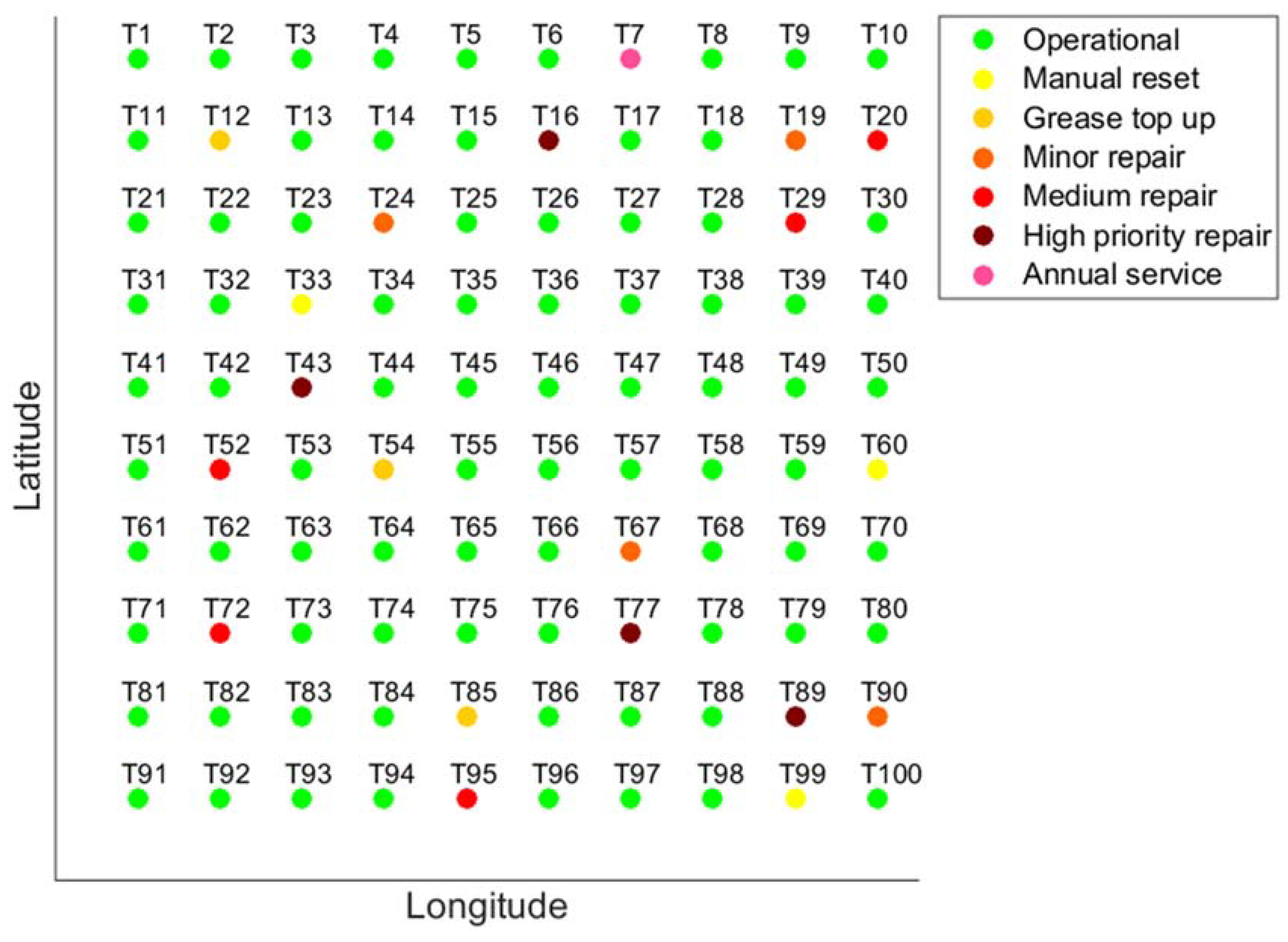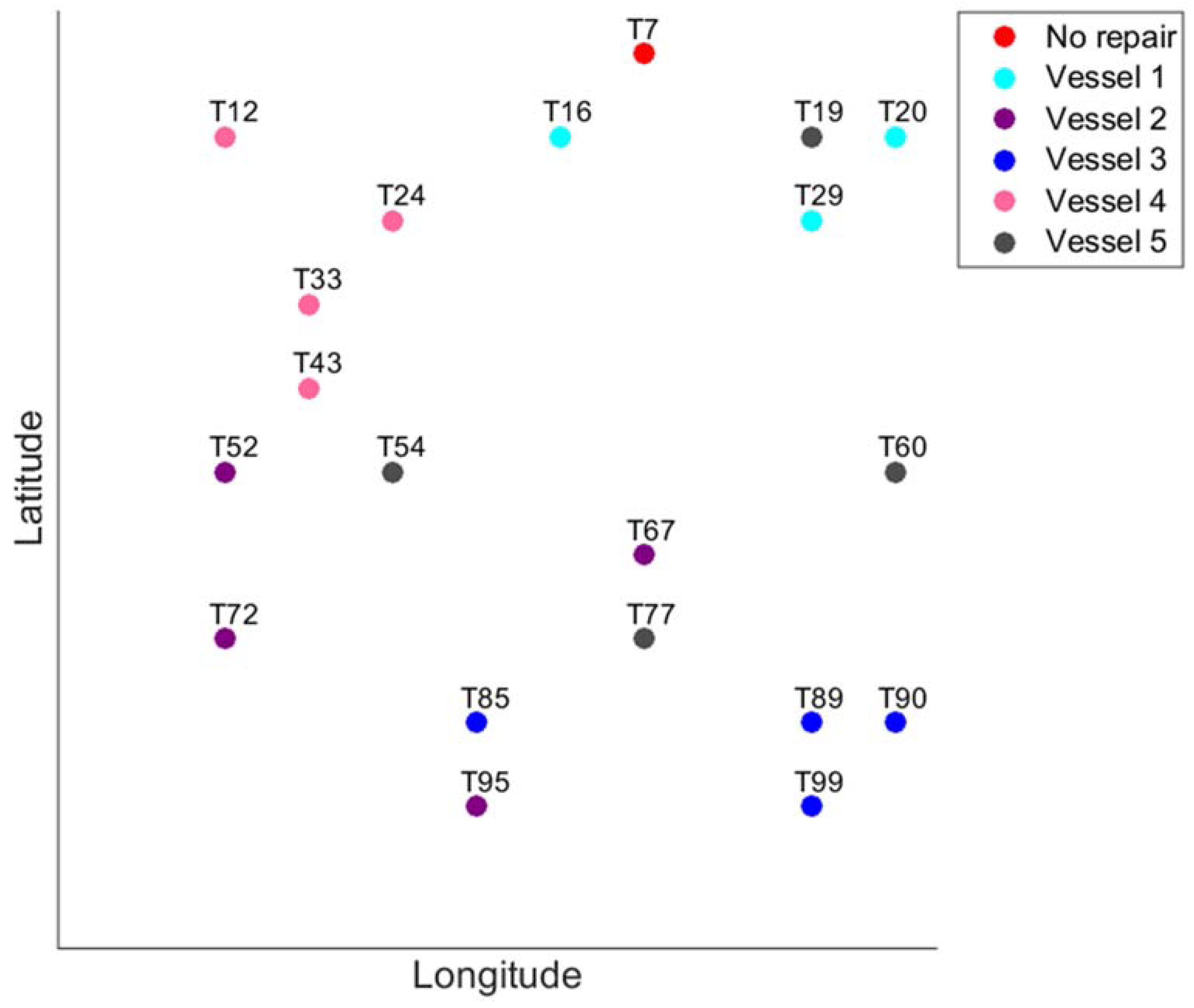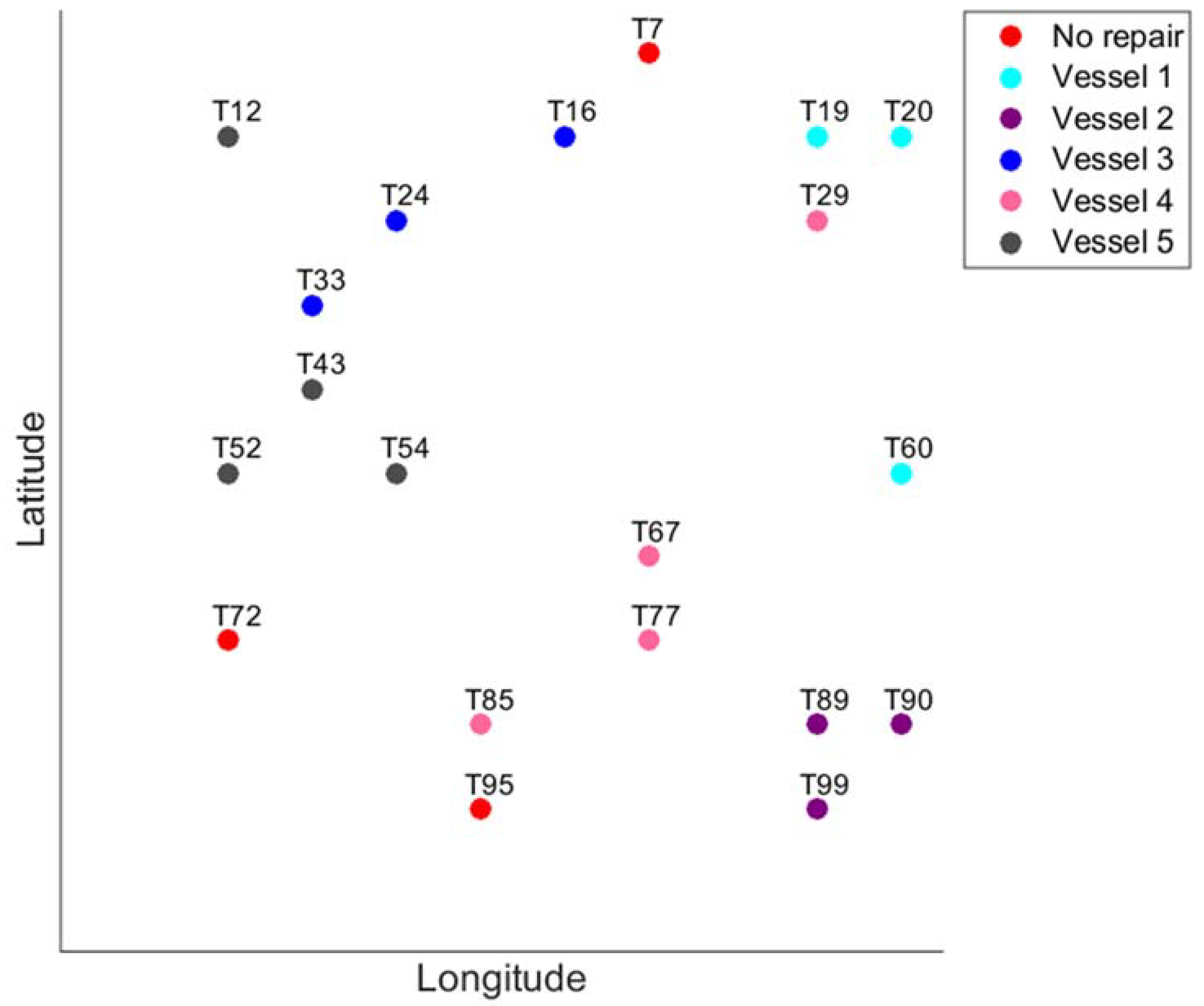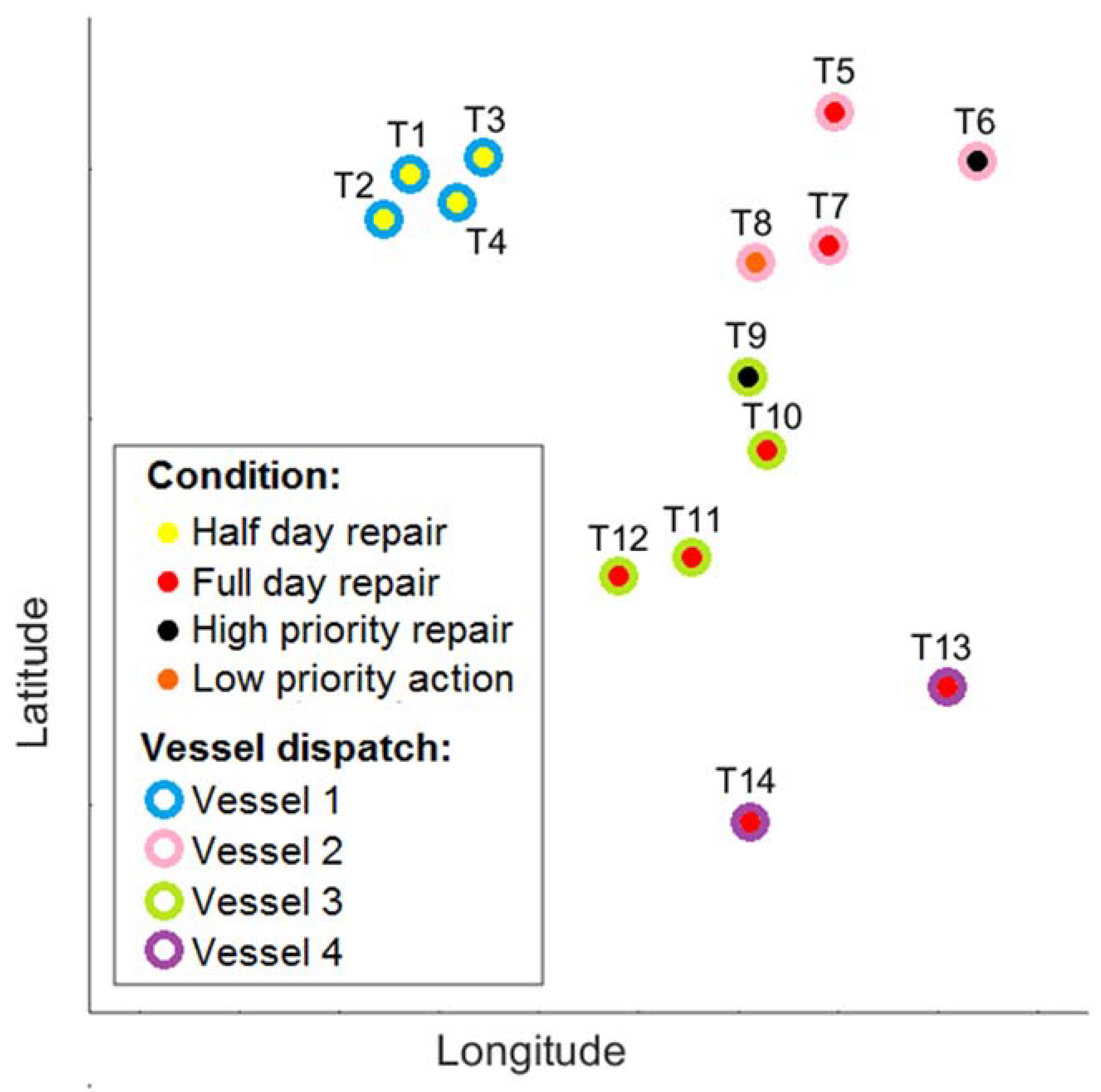Decision Support Tool for Offshore Wind Farm Vessel Routing under Uncertainty
Abstract
:1. Introduction
2. Materials and Methods
2.1. Model Structure
- Each turbine is visited by one vessel only (Equation (2)).
- Each cluster can only be assigned one of the vessels (Equation (3)).
- The number of technicians required does not exceed the number of technicians available on the day (Equation (4)).
2.2. Calculating the Probability of Carrying out Successful Maintenance Actions
2.2.1. Methodology
2.2.2. Risk Aversion Factor and Value Function
- (a)
- There is an ample amount of slack time to allow for some repairs taking longer than expected. If high risk aversion is specified, the model is encouraged to select faster vessels to carry out repairs on clusters that are expected to take longer.
- (b)
- Assignment of vessels with inferior transfer capability to turbines with expected high waves is discouraged.
- (c)
- Turbines that have a high likelihood of being maintained (low or no possibility of incorrect diagnosis) are prioritised.
- (a)
- Planning to visit fewer turbines does not mean that fewer turbines will be maintained; the opposite may be true in the presence of uncertainties on the expected maintenance duration.
- (b)
- Leaving unfinished maintenance on the turbine (particularly in the nacelle) often results in wasted technician time. For example, if the last maintenance action of the day takes longer than expected, technicians may need to leave the turbine and head back to base without completing the task to comply with maximum working hours regulations. Time is then wasted the next time the turbine is visited, e.g., the following day, as technicians need to transfer to/from a vessel, and climb up/down the nacelle for the second time.
- (c)
- The assignment of vessels to clusters is no longer based only on its capacity, fuel consumption, and the ability to meet the time constraint, but also on its capability to transfer crews onto turbines in a given wave height.
2.3. Evaluation of Policy against Key Performance Indicators (KPIs)
- (a)
- Maximisation of the number wind turbine visits.
- (b)
- Maximisation of the number of high reward wind turbine visits.
- (c)
- Minimisation of costs.
- (d)
- Minimisation of the number of unsuccessful repairs (due to uncertainty realisations).
- (a)
- One to determine the actual maintenance action time, which is calculated using the inverse of the gamma cumulative distribution function (i.e., inverse of Equation (7)).
- (b)
- One to determine whether the transfer of crew onto the turbine will be possible.
- (c)
- One to determine whether the turbine was correctly diagnosed.
3. Results
3.1. Case Study 1
3.1.1. Model Inputs
3.1.2. Model Outputs
3.2. Case Study 2
- Half-day repairs, which tend to take around 2–3 h.
- Full day repairs, which tend to take around 5–7 h.
- High priority full day repairs involve turbines that have stopped generating power, and are to be visited as early as possible to maximise the time that technicians have on the turbine.
- Low priority maintenance actions, such as for example statutory tasks/inspections.
- Operators tend not to assign one vessel to visit more than one turbine requiring high priority repair. Spreading crews carrying out these repairs across a number of vessels lowers the overall risk, as in some cases, due to unforeseen circumstances, a vessel may have to turn back to base before reaching the wind farm.
- It is preferred that certain maintenance actions are carried out by teams of three, although they can be completed by just two technicians if necessity arises.
- If a particular technician is assigned to travel on a vessel different to the one they were on the previous day, time has to be taken out of the overall time window to allow for craning their tools and equipment over.
4. Conclusions
Supplementary Materials
Author Contributions
Funding
Conflicts of Interest
Abbreviation
| η | number of turbines in a cluster |
| A | risk aversion factor |
| a | shape parameter (Gamma distribution) |
| b | scale parameter (Gamma distribution) |
| Cfj | fuel cost for vessel j |
| Cri | cost of maintaining wind turbine i |
| Dk | number of technicians required to carry out maintenance on route k |
| E | number of technicians available |
| Fp | policy value (reward) |
| G | set of turbines (in a cluster/route) |
| i | turbine identifier |
| j | vessel identifier |
| K | set of feasible vessel routes |
| Ntj | number of turbines visited by vessel j |
| Pdi | probability of correct diagnosis of turbine i |
| Pri | probability of maintenance time at turbine i being less than the time available |
| Ptij | probability of successfully transferring crew from vessel j onto turbine i |
| Pvj | probability of vessel j being able to service all maintenance tasks assigned to it |
| Qk | binary decision variable (whether route k is selected) |
| Ri | expected maintenance time at turbine i |
| Sik | binary parameter (whether turbine i is on route k) |
| Ui | reward for maintaining turbine i |
| Vkj | binary parameter (whether vessel j is assigned to route k) |
| Xi | time available for maintenance atcions at turbine i |
| Y | critical path slack time |
| Z | non-critical path slack time |
References
- Ho, A.; Mbistrova, A. The European Offshore Wind Industry: Key Trends and Statistics 2016. Available online: https://windeurope.org/wp-content/uploads/files/about-wind/statistics/WindEurope-Annual-Offshore-Statistics-2016.pdf (accessed on 25 July 2018).
- The Crown Estate. Offshore Wind Cost Reduction: Pathways Study. Available online: https://www.thecrownestate.co.uk/media/5493/ei-offshore-wind-cost-reduction-pathways-study.pdf (accessed on 29 May 2017).
- Newman, M. Operations and Maintenance in Offshore Wind: Key Issues for 2015/16, Report by ORE Catapult. Available online: https://pdfs.semanticscholar.org/93ac/c7c22b705811c153679ee49d8f256ae21f77.pdf (accessed on 29 August 2018).
- Irawan, C.A.; Ouelhadj, D.; Jones, D.; Stålhane, M.; Sperstad, I.B. Optimisation of maintenance routing and scheduling for offshore wind farms. Eur. J. Oper. Res. 2017, 256, 76–89. [Google Scholar] [CrossRef] [Green Version]
- Dai, L.; Stålhane, M.; Utne, I.B. Routing and Scheduling of Maintenance Fleet for Offshore Wind Farms. Wind Eng. 2014, 39, 15–30. [Google Scholar] [CrossRef]
- Zhang, Z. Scheduling and Routing Optimization of Maintenance Fleet for Offshore Wind Farms using Duo-ACO. Adv. Mater. Res. 2014, 1039, 294–301. [Google Scholar] [CrossRef]
- Stålhane, M.; Hvattum, L.M.; Skaar, V. Optimization of Routing and Scheduling of Vessels to Perform Maintenance at Offshore Wind Farms. Energy Proc. 2015, 80, 92–99. [Google Scholar] [CrossRef]
- Caceres-Cruz, J.; Pol, A.; Guimarans, D.; Riera, D.; Juan, A.A. Rich Vehicle Routing Problem: Survey. ACM Comput. Surv. 2014, 47, 1–28. [Google Scholar] [CrossRef]
- Shafiee, M. Maintenance logistics organization for offshore wind energy: current progress and future perspectives. Renew. Energy 2015, 77, 182–193. [Google Scholar] [CrossRef]
- Dawid, R.; McMillan, D.; Revie, M. Development of an O&M Tool for Short Term Decision Making Applied to Offshore Wind Farms. Available online: https://www.researchgate.net/publication/312970476_Development_of_an_OM_tool_for_short_term_decision_making_applied_to_offshore_wind_farms (accessed on 14 May 2018).
- IBM ILOG CPLEX Optimization Studio V12.6.1 User Manual. Available online: https://www.ibm.com/support/knowledgecenter/SSSA5P_12.6.1/ilog.odms.studio.help/Optimization_Studio/topics/COS_home.html (accessed on 20 August 2018).
- Sun, L.; Wang, B. Robust Optimisation Approach for Vehicle Routing Problems with Uncertainty. Math. Probl. Eng. 2015, 2015. [Google Scholar] [CrossRef]
- Allahviranloo, M.; Chow, J.Y.J.; Recker, W.W. Selective vehicle routing problems under uncertainty without recourse. Transp. Res. Part E 2014, 62, 68–88. [Google Scholar] [CrossRef]
- Moghaddam, B.; Ruiz, R.; Sadjadi, S. Computers & Industrial Engineering Vehicle routing problem with uncertain demands: An advanced particle swarm algorithm. Comput. Ind. Eng. 2012, 62, 306–317. [Google Scholar]
- Marinakis, Y.; Iordanidou, G.; Marinaki, M. Particle Swarm Optimization for the Vehicle Routing Problem with Stochastic Demands. Appl. Soft Comput. J. 2013, 13, 1693–1704. [Google Scholar] [CrossRef]
- Tas, D.; Dellaert, N.; Woensel, T.V.; Kok, T.D. Vehicle routing problem with stochastic travel times including soft time windows and service costs. Comput. Oper. Res. 2013, 40, 214–224. [Google Scholar] [CrossRef] [Green Version]
- Russell, R.A.; Urban, T.L. Vehicle routing with soft time windows and Erlang travel times. Oper. Res. Soc. 2008, 59, 1220–1228. [Google Scholar] [CrossRef]
- Oyola, J.; Arntzen, H.; Woodruff, D.L. The stochastic vehicle routing problem, a literature review, part I: models. EURO J. Transp. Logist. 2016. [Google Scholar] [CrossRef]
- Li, X.; Tian, P.; Leung, S.C.H. Vehicle routing problems with time windows and stochastic travel and service times: Models and algorithm. Int. J. Prod. Econ. 2010, 125, 137–145. [Google Scholar] [CrossRef]
- Lei, H.; Laporte, G.; Guo, B. A generalized variable neighborhood search heuristic for the capacitated vehicle routing problem with stochastic service times. J. Span. Soc. Stat. Oper. Res. 2012, 20, 99–118. [Google Scholar] [CrossRef]
- Chen, L.; Hoàng, M.; Langevin, A.; Gendreau, M. Optimizing road network daily maintenance operations with stochastic service and travel times. Transp. Res. Part E 2014, 64, 88–102. [Google Scholar] [CrossRef]
- Gómez, A.; Mariño, R.; Akhavan-Tabatabaei, R.; Medaglia, A.L.; Mendoza, J.E. On Modeling Stochastic Travel and Service Times in Vehicle Routing. Transp. Sci. 2016, 50, 627–641. [Google Scholar] [CrossRef]
- Bertsimas, D.J.; van Ryzin, G. Stochastic and Dynamic Vehicle Routing with General Demand and Interarrival Time Distributions. Adv. Appl. Probab. 1993, 25, 947–978. [Google Scholar] [CrossRef]
- Chepuri, C.; Homem-De-Mello, T. Solving the vehicle routing problem with stochastic demands and customers. Ann. Oper. Res. 2005, 153–181. [Google Scholar] [CrossRef]
- Dawid, R.; McMillan, D.; Revie, M. Time Series Semi-Markov Decision Process with Variable Costs for Maintenance Planning. Available online: https://strathprints.strath.ac.uk/58070/1/Dawid_etal_Esrel2016_Time_series_semi_markov_ decision_process.PDF (accessed on 25 July 2018).
- Dinwoodie, I.; Endrerud, O.-E.V.; Hofmann, M.; Martin, R.; Sperstad, I.B. Reference Cases for Verification of Operation and Maintenance Simulation Models for Offshore Wind Farms. Wind Eng. 2015, 39, 1–14. [Google Scholar] [CrossRef] [Green Version]






| Policy Characteristics | Case 1 | Case 2 | Case 3 | Case 4 | Case 5 |
|---|---|---|---|---|---|
| Risk aversion factor (A) | 0 | 2.5 | 5 | 7.5 | 10 |
| Planned number of turbines to be maintained (/20) | 19 | 18 | 17 | 16 | 14 |
| Planned number of high priority turbines to be maintained (/4) | 4 | 4 | 4 | 4 | 4 |
| Expected policy value (not including value added due to a non-zero A) (£ ,000) | 1685.1 | 1603.3 | 1522.5 | 1440.7 | 1277.9 |
| Number of technicians required to carry out all of the maintenance actions | 45 | 44 | 45 | 40 | 34 |
| From Monte Carlo simulation (as described in Section 3.2): | |||||
| Average number of turbines actually maintained (/20) | 10.8 | 10.8 | 12.1 | 11.1 | 11.5 |
| Turbines not maintained due to actions taking longer than expected | 5.6 | 4.9 | 3.1 | 3 | 1.3 |
| Turbines not maintained due to unsuccessful transfer | 1.2 | 1 | 0.6 | 0.8 | 0.2 |
| Turbines not maintained due to incorrect diagnosis | 1.4 | 1.3 | 1.2 | 1.1 | 1 |
| Case | Vessel | Probability | Tech. Crews | Turbines Visited | Order of Visits | |||||||
|---|---|---|---|---|---|---|---|---|---|---|---|---|
| Case 1 | Vessel 1 | 20.2% | 3 | 3 | T20 | T29 | T16 | T16 | T20 | T29 | ||
| Vessel 2 | 9.8% | 4 | 4 | T52 | T72 | T95 | T67 | T67 | T52 | T72 | T95 | |
| Vessel 3 | 18.5% | 3 | 4 | T85 | T89 | T90 | T85 | T99 | T90 | T89 | T99 | |
| Vessel 4 | 19.3% | 3 | 4 | T12 | T43 | T24 | T12 | T33 | T24 | T43 | T33 | |
| Vessel 5 | 17.3% | 3 | 4 | T54 | T77 | T19 | T54 | T60 | T19 | T77 | T60 | |
| Case 3 | Vessel 1 | 53.3% | 3 | 3 | T20 | T19 | T60 | T60 | T19 | T20 | ||
| Vessel 2 | 54.3% | 3 | 3 | T89 | T90 | T99 | T99 | T90 | T89 | |||
| Vessel 3 | 44.8% | 3 | 3 | T16 | T24 | T33 | T33 | T24 | T16 | |||
| Vessel 4 | 12.4% | 4 | 4 | T29 | T77 | T67 | T85 | T85 | T67 | T77 | T29 | |
| Vessel 5 | 14.4% | 4 | 4 | T52 | T43 | T54 | T12 | T54 | T12 | T43 | T52 | |
| Vessel | Order Source | Drop-Off Order | Difference in Distance Travelled (km) | |||
|---|---|---|---|---|---|---|
| Vessel 1 | Actual | 2 | 4 | 3 | 1 | 0.42 |
| Tool | 3 | 2 | 4 | 1 | ||
| Vessel 2 | Actual | 6 | 5 | 7 | 8 | 0 |
| Tool | 6 | 5 | 7 | 8 | ||
| Vessel 3 | Actual | 9 | 11 | 12 | 10 | 3.58 |
| Tool | 9 | 10 | 11 | 12 | ||
| Vessel 4 | Actual | 13 | 14 | 0 | ||
| Tool | 13 | 14 | ||||
© 2018 by the authors. Licensee MDPI, Basel, Switzerland. This article is an open access article distributed under the terms and conditions of the Creative Commons Attribution (CC BY) license (http://creativecommons.org/licenses/by/4.0/).
Share and Cite
Dawid, R.; McMillan, D.; Revie, M. Decision Support Tool for Offshore Wind Farm Vessel Routing under Uncertainty. Energies 2018, 11, 2190. https://doi.org/10.3390/en11092190
Dawid R, McMillan D, Revie M. Decision Support Tool for Offshore Wind Farm Vessel Routing under Uncertainty. Energies. 2018; 11(9):2190. https://doi.org/10.3390/en11092190
Chicago/Turabian StyleDawid, Rafael, David McMillan, and Matthew Revie. 2018. "Decision Support Tool for Offshore Wind Farm Vessel Routing under Uncertainty" Energies 11, no. 9: 2190. https://doi.org/10.3390/en11092190




